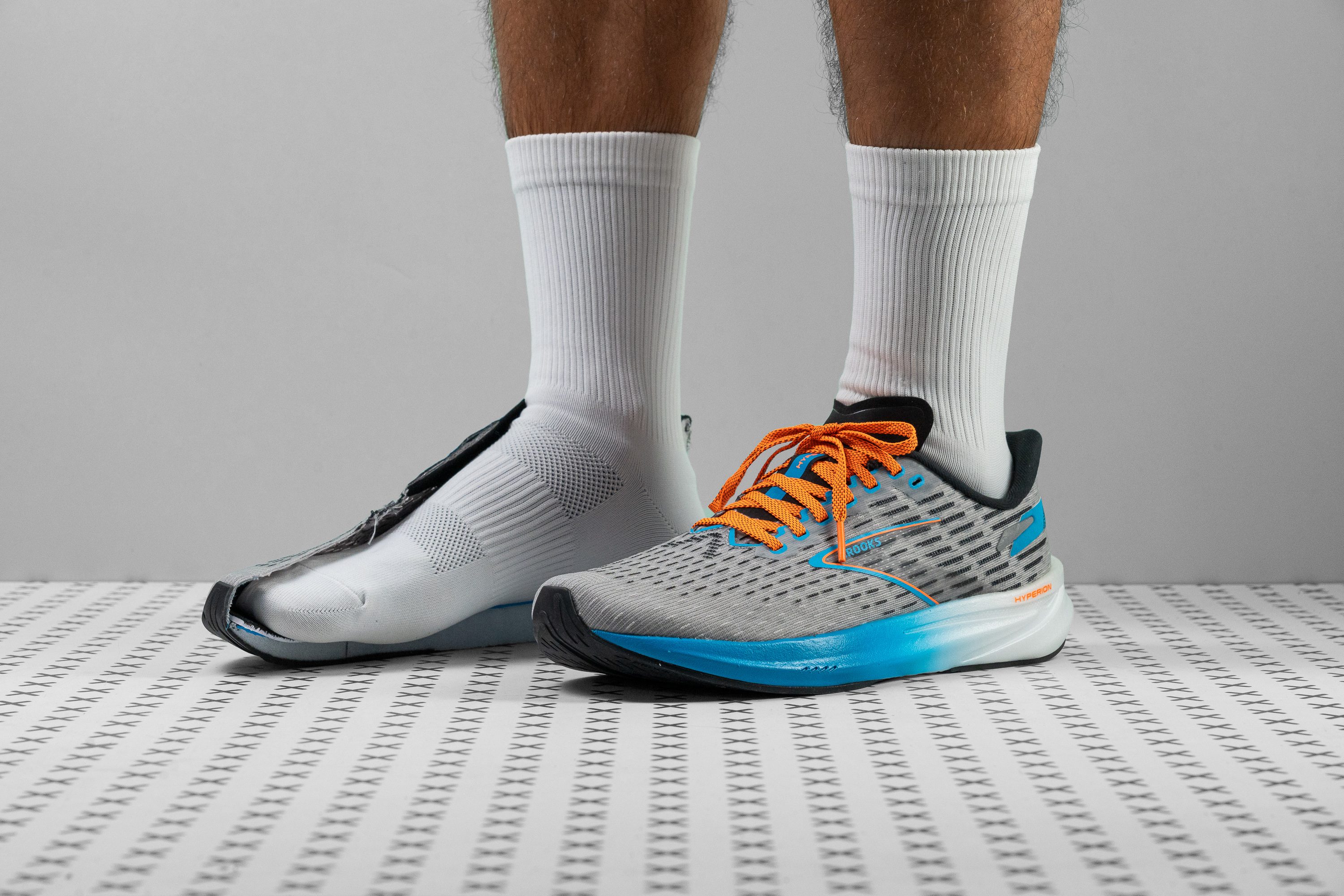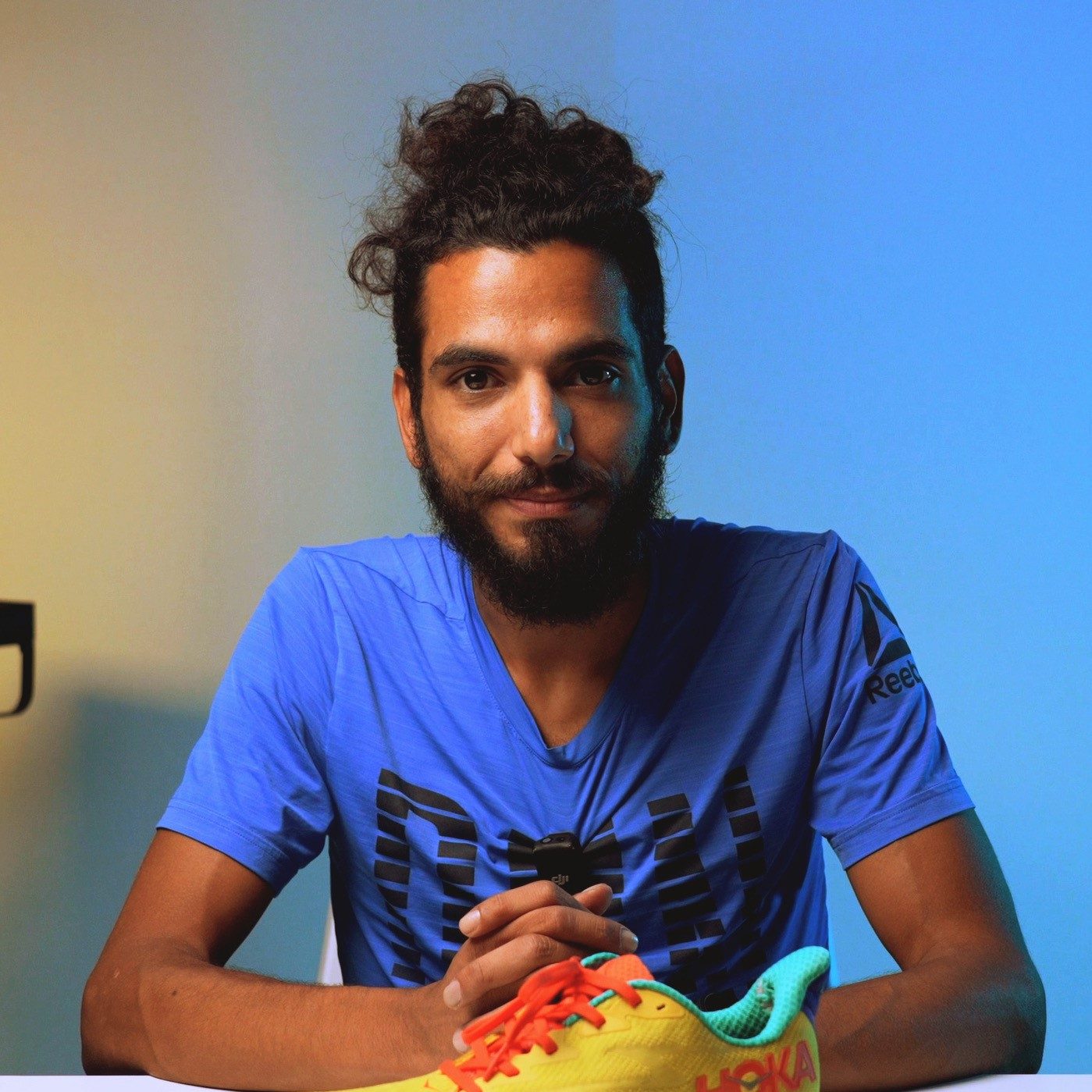Our verdict
- Top pick in best Brooks running shoes (2023)
Pros
- Great for uptempo runs
- Fast and responsive ride
- Well cushioned for impact
- Flexible and forgiving underfoot
- Lightweight
- Stable cornering
- Grippy outsole
- Accommodating toebox
- Secure lockdown
- Great value
Cons
- Much higher heel drop than expected
- Average at best breathability
- Upper lacks durability
- Feels different depending on weather
Audience verdict
- Top 23% most popular running shoes
Comparison
The most similar running shoes compared
+ + Add a shoe | |||||
|---|---|---|---|---|---|
| Audience score | 88 Great! | 89 Great! | 66 Bad! | 89 Great! | |
| Price | £130 | £150 | £140 | £140 | |
| Pace | Tempo | Tempo | Daily runningTempo | Daily runningTempo | |
| Shock absorption | - | Moderate | Moderate | Low | |
| Energy return | - | Low | Moderate | Low | |
| Traction | - | Moderate | High | Moderate | |
| Arch support | Neutral | Neutral | Neutral | Neutral | |
| Weight lab Weight brand | 7.4 oz / 211g 7.6 oz / 215g | 7 oz / 198g 7 oz / 199g | 8.6 oz / 244g 8.6 oz / 244g | 8.5 oz / 240g 8.1 oz / 229g | |
| Lightweight | ✓ | ✓ | ✗ | ✓ | |
| Drop lab Drop brand | 12.3 mm 8.0 mm | 9.0 mm 8.0 mm | 11.3 mm 8.0 mm | 10.1 mm 6.0 mm | |
| Strike pattern | Heel | HeelMid/forefoot | - | Heel | |
| Size | True to size | True to size | True to size | True to size | |
| Midsole softness | Balanced | Balanced | Balanced | Firm | |
| Difference in midsole softness in cold | Big | Small | Small | Small | |
| Toebox durability | Bad | Good | Decent | Decent | |
| Heel padding durability | Decent | Decent | Good | Bad | |
| Outsole durability | Good | Good | Good | Good | |
| Breathability | Moderate | Moderate | Breathable | Moderate | |
| Width / fit | Narrow | Medium | Medium | Medium | |
| Toebox width | Wide | Medium | Medium | Wide | |
| Stiffness | Moderate | Flexible | Moderate | Moderate | |
| Torsional rigidity | Flexible | Flexible | Stiff | Flexible | |
| Heel counter stiffness | Moderate | Moderate | Stiff | Flexible | |
| Heel lab Heel brand | 30.0 mm 22.0 mm | 28.7 mm 28.0 mm | 36.5 mm 36.0 mm | 27.9 mm 28.0 mm | |
| Forefoot lab Forefoot brand | 17.7 mm 14.0 mm | 19.7 mm 20.0 mm | 25.2 mm 28.0 mm | 17.8 mm 22.0 mm | |
| Widths available | Normal | Normal | Normal | Normal | |
| Orthotic friendly | ✓ | ✓ | ✗ | ✓ | |
| Season | All seasons | All seasons | - | All seasons | |
| Removable insole | ✓ | ✓ | ✗ | ✓ | |
| Ranking | #266 Top 41% | #96 Top 26% | #370 Bottom 1% | #82 Top 23% | |
| Popularity | #148 Top 23% | #176 Top 48% | #143 Top 39% | #97 Top 27% |
Who should buy
We recommend the Brooks Hyperion to runners who:
- Want a lightweight shoe with plenty of pep in its step for uptempo days
- Prefer flexible shoes that are capable of speed without relying on a stiff plate
- Are fans the previous model; the Brooks Hyperion Tempo
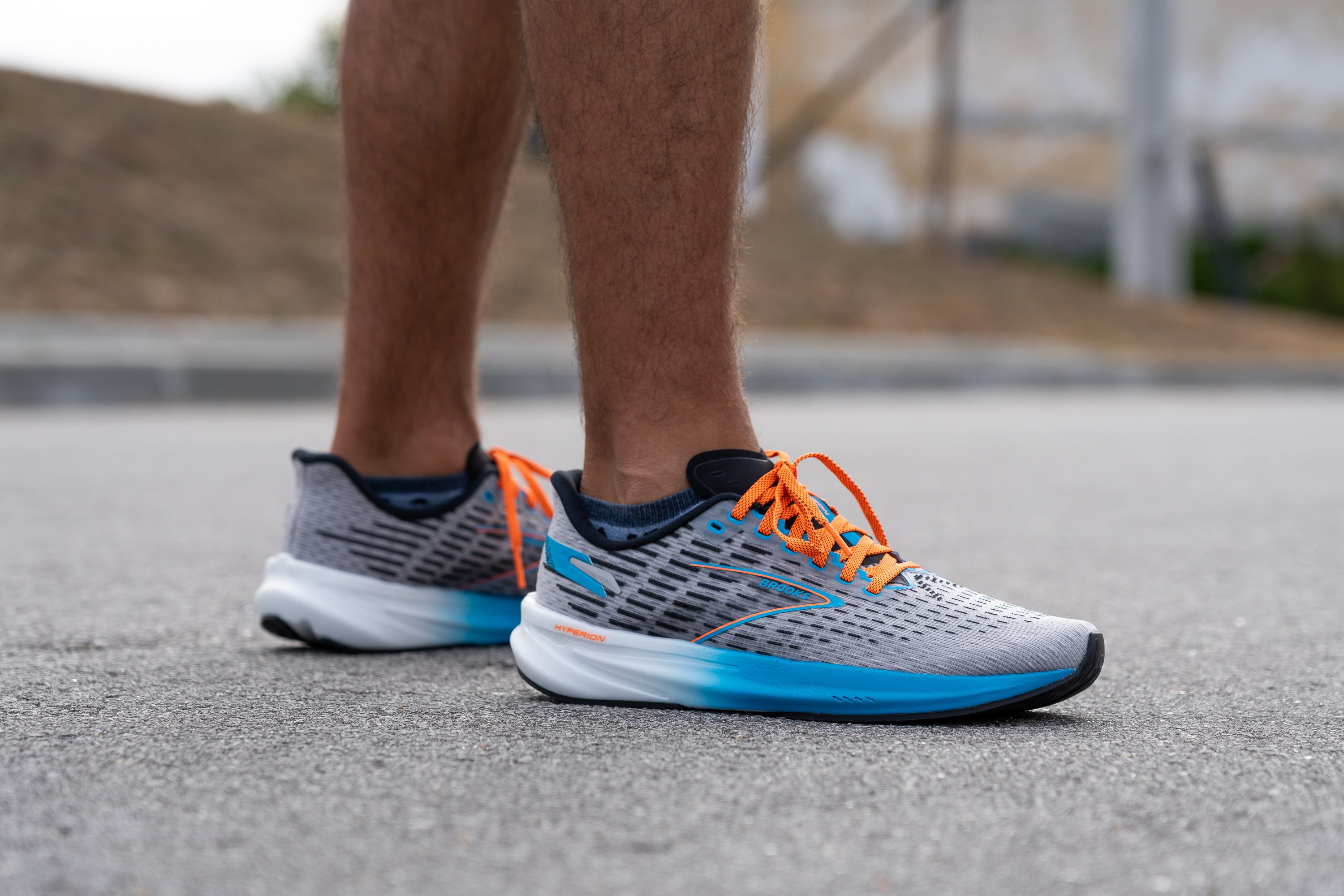
Who should NOT buy
While the Hyperion can adequately serve as a casual or intermediate runner’s first pair of racing flats, more advanced runners will benefit from more advanced features to give them an edge on the starting line. We recommend the ASICS Magic Speed 2 or the Saucony Endorphin Speed 3 as more state of the art, if slightly more expensive, alternatives.
Distance runners who prefer more cushioning underfoot will find the Hyperion’s midsole to be lacking for those long haul efforts. Instead, we recommend checking out the Brooks Launch 10 or the Adidas Adizero Boston 12 as alternatives that can go fast and far.
We found large discrepancies in the shoe’s stack measurements, leaving the Hyperion with a steep drop height of 12.8 mm compared to the 8 mm stated by Brooks. For runners in the market for a speedy shoe that actually does boast a medium heel drop, we suggest having a look at the ASICS Novablast 3 instead.
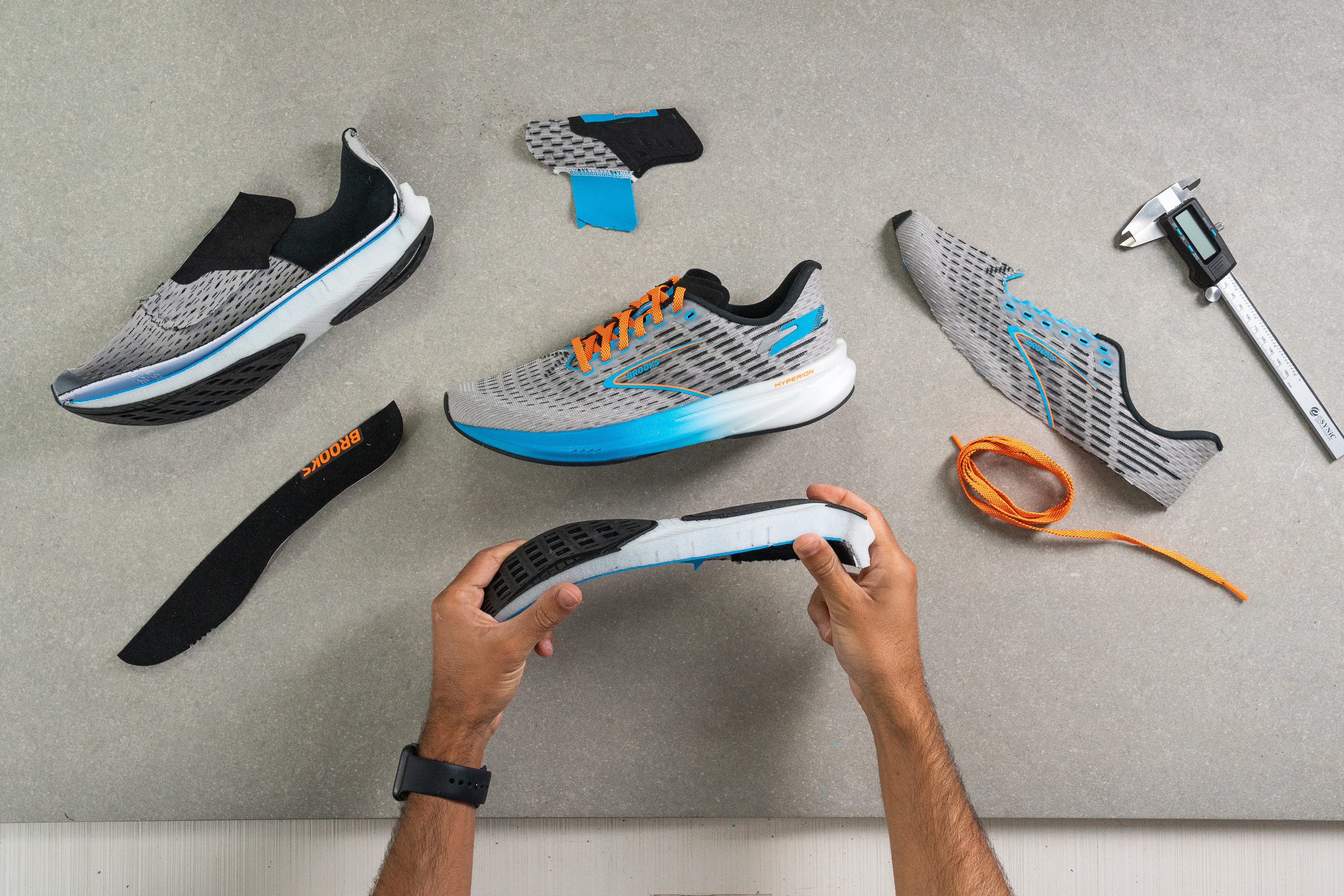
Cushioning
Heel stack
We had to make sure our caliper was calibrated correctly when measuring the Hyperion’s heel stack. We found it to be 30 mm tall which makes the 22 mm officially stated by Brooks highly inaccurate. This is still a little shorter than the average of shoes we’ve tested in the lab so far, but provides more than enough foam for heel striking runners to appreciate the shoe’s cushioning,
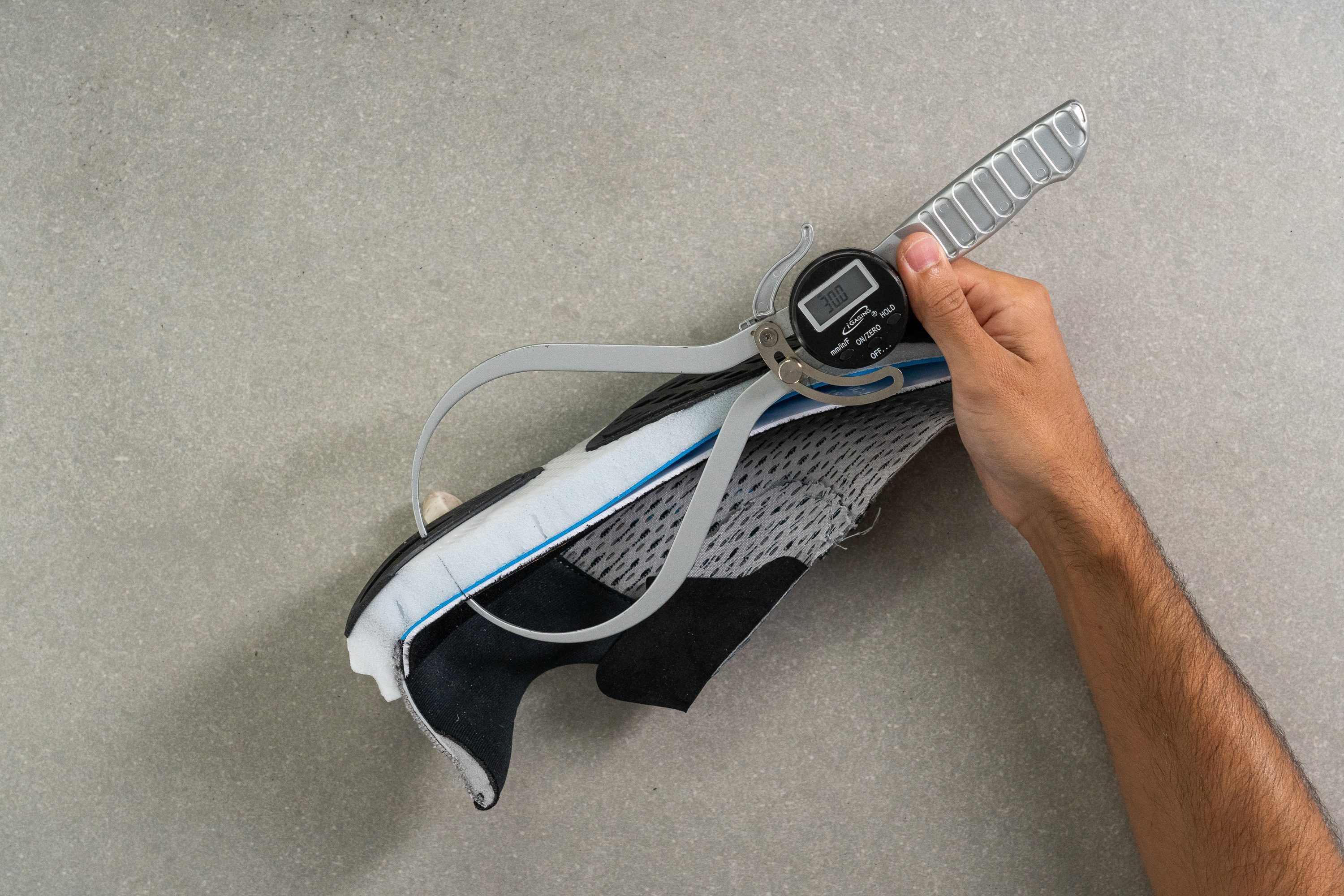
| Hyperion | 30.0 mm |
| Average | 34.8 mm |
Forefoot stack
The Hyperion’s advertised forefoot stack measurement is also inaccurate, but not as dramatically as at the heel. We found it to be 17.7 mm tall versus the 14 mm according to the shoe’s specs. This provides runners with a good level of impact protection while also allowing for a certain level of ground-feel underfoot that is more natural and comfortable for some runners.
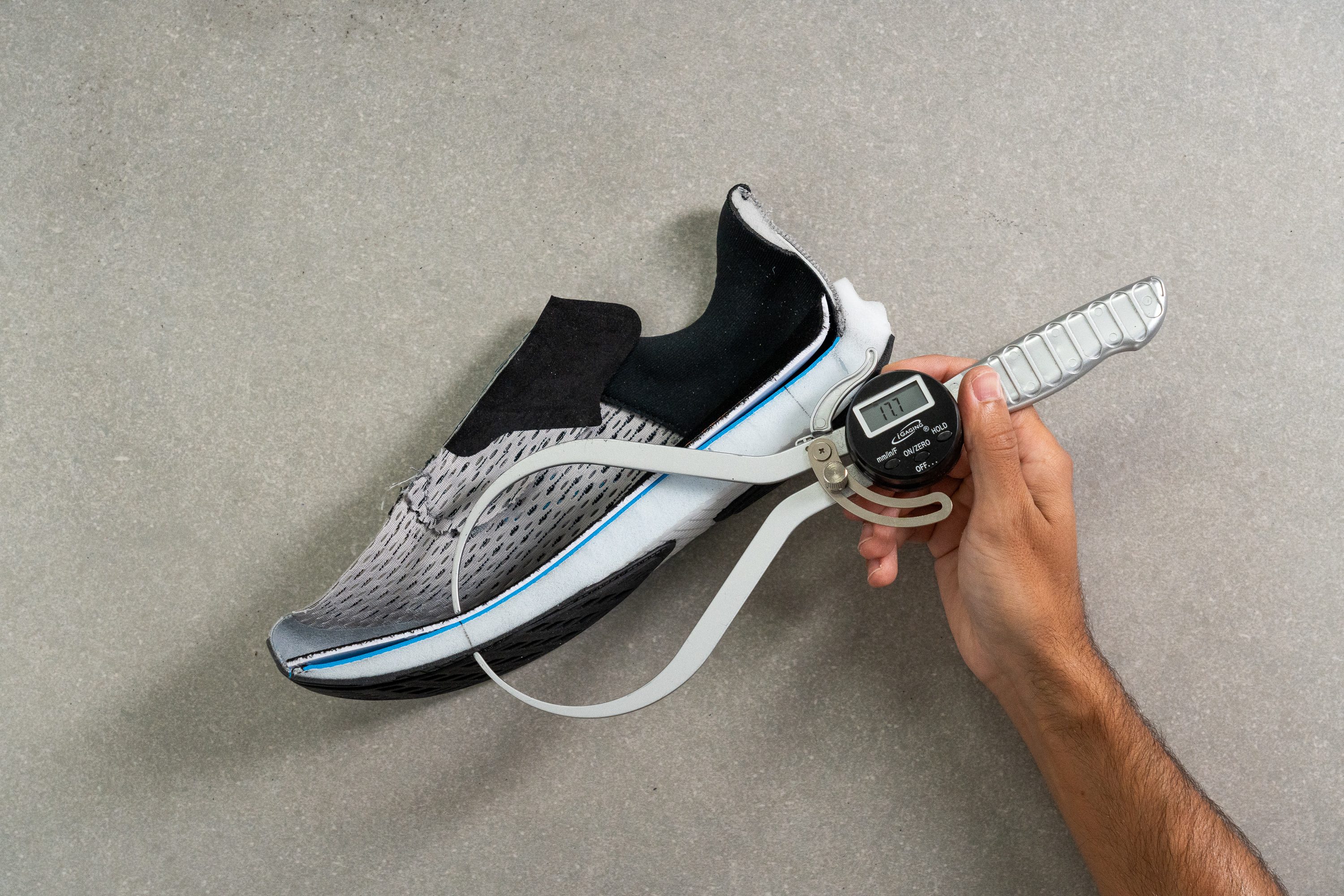
| Hyperion | 17.7 mm |
| Average | 26.2 mm |
Drop
While the official 8 mm drop height classifies the Hyperion as a mid-drop shoe, the difference in our accurate stack measurements leaves us with a drop of 12.3 mm which makes it a high-drop shoe. This steep drop tends to benefit heel strikers over their forefoot striking counterparts as it provides more rearfoot cushioning and promotes smoother heel-to-toe transitions. For those looking for a speedy shoe that actually falls in the category of mid-drop shoes, we recommend the Saucony Endorphin Speed 3 (7.4 mm) or the ASICS Novablast 3 (6.8 mm).
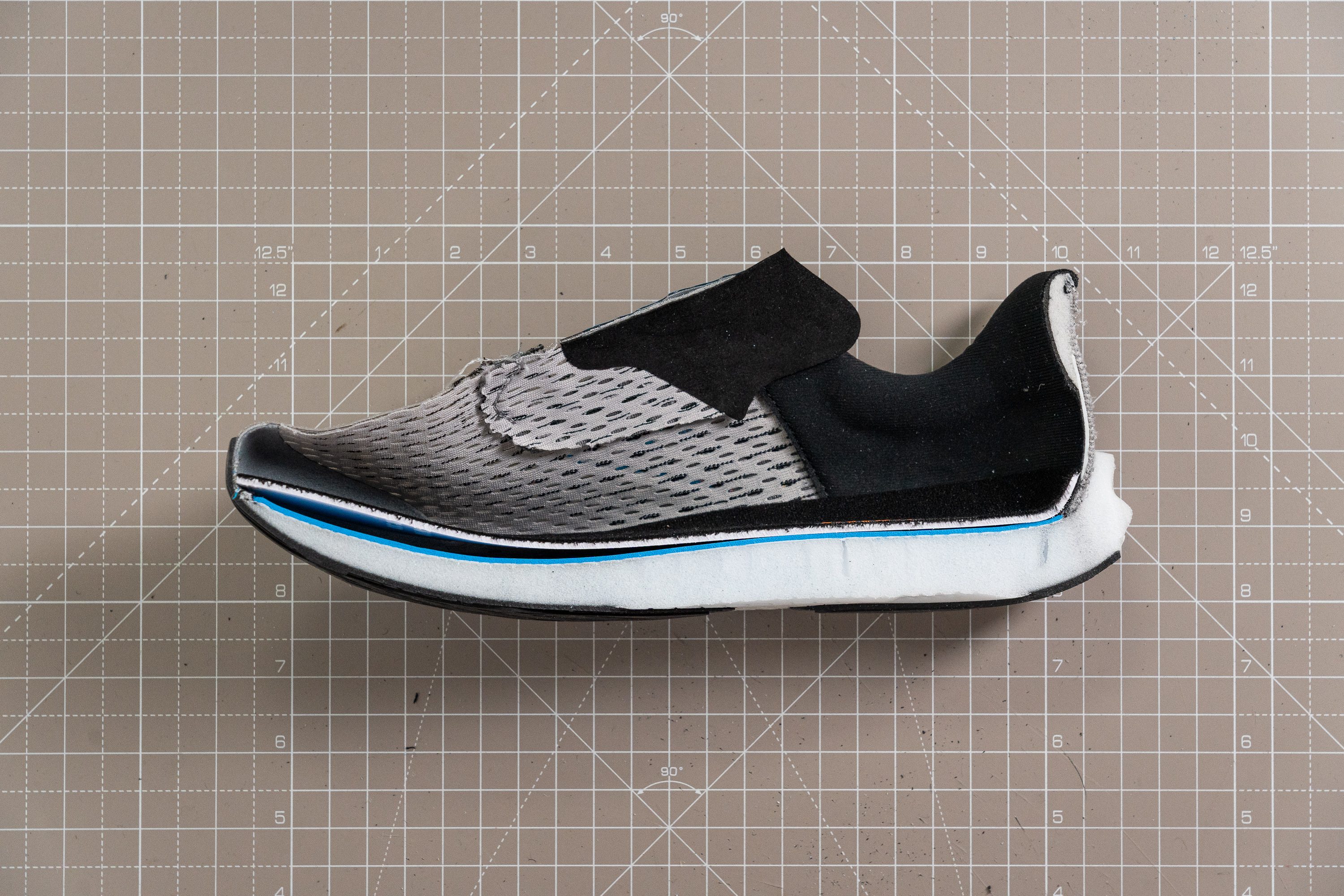
For an in-depth look at the disparity in brand stated drop heights vs reality, check out our article on the matter written by the very knowledgeable Carlos Sánchez using data we’ve compiled from the shoes we’ve tested in the lab so far.
| Hyperion | 12.3 mm |
| Average | 8.6 mm |
Midsole softness
With a durometer reading of 20.5 HA, the Hyperion’s updated DNA Flash midsole is quite a bit softer than our current lab average and lies at the threshold between plush and balanced cushioning. Indeed, the shoe does feel cushy underfoot but doesn’t give us that gummy, sinking feeling sometimes associated with softer midsoles; with a ride that’s responsive and smooth without being too bouncy.
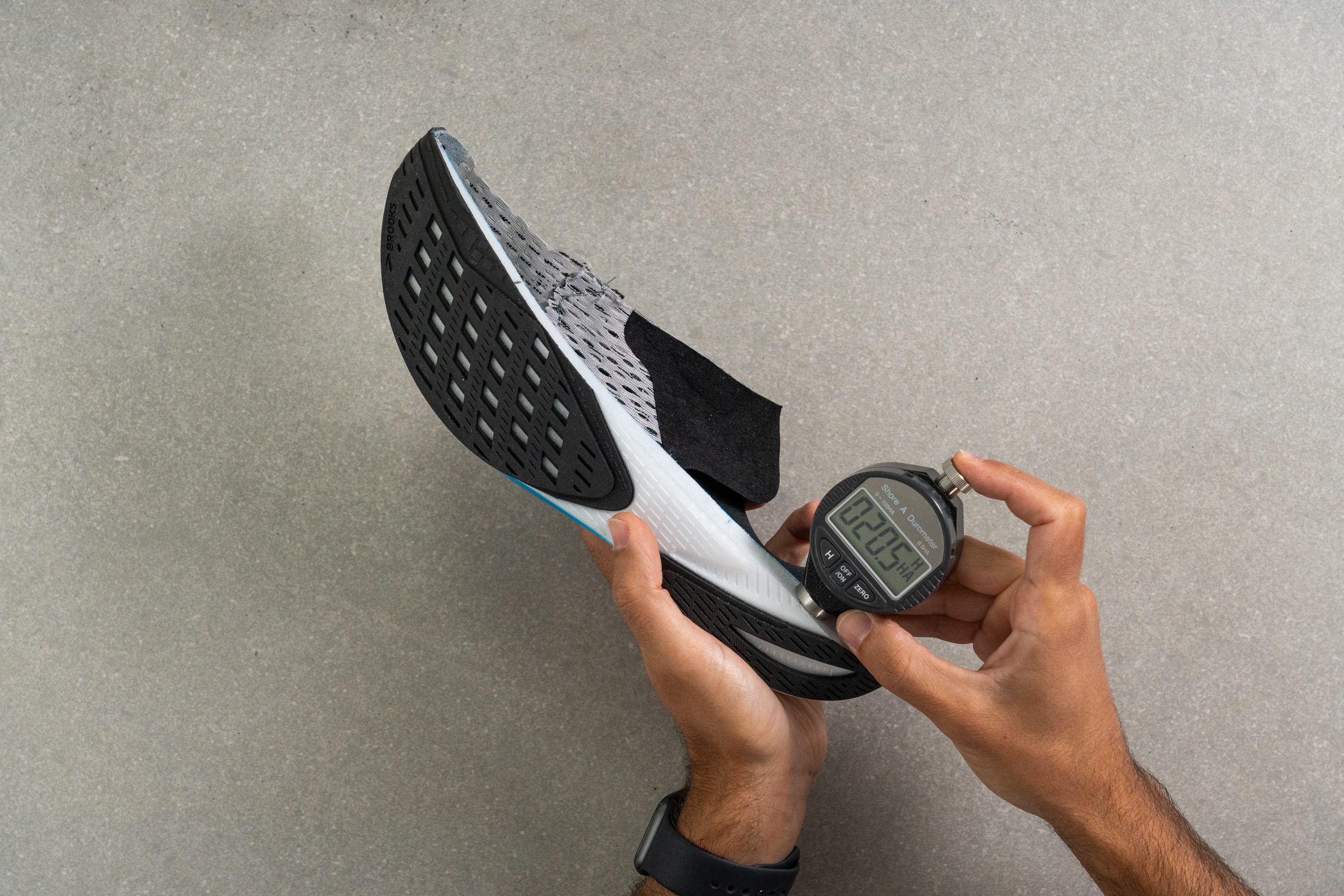
| Hyperion | 20.6 HA |
| Average | 20.4 HA |
Size and fit
Size
Brooks Hyperion fits true to size (125 votes).
Toebox width - widest part
We measured the toebox to be 97.9 mm at its widest point which makes it just about as wide as our current lab average. This combined with the Hyperion’s delicate upper mesh means that the shoe will accommodate most foot shapes.
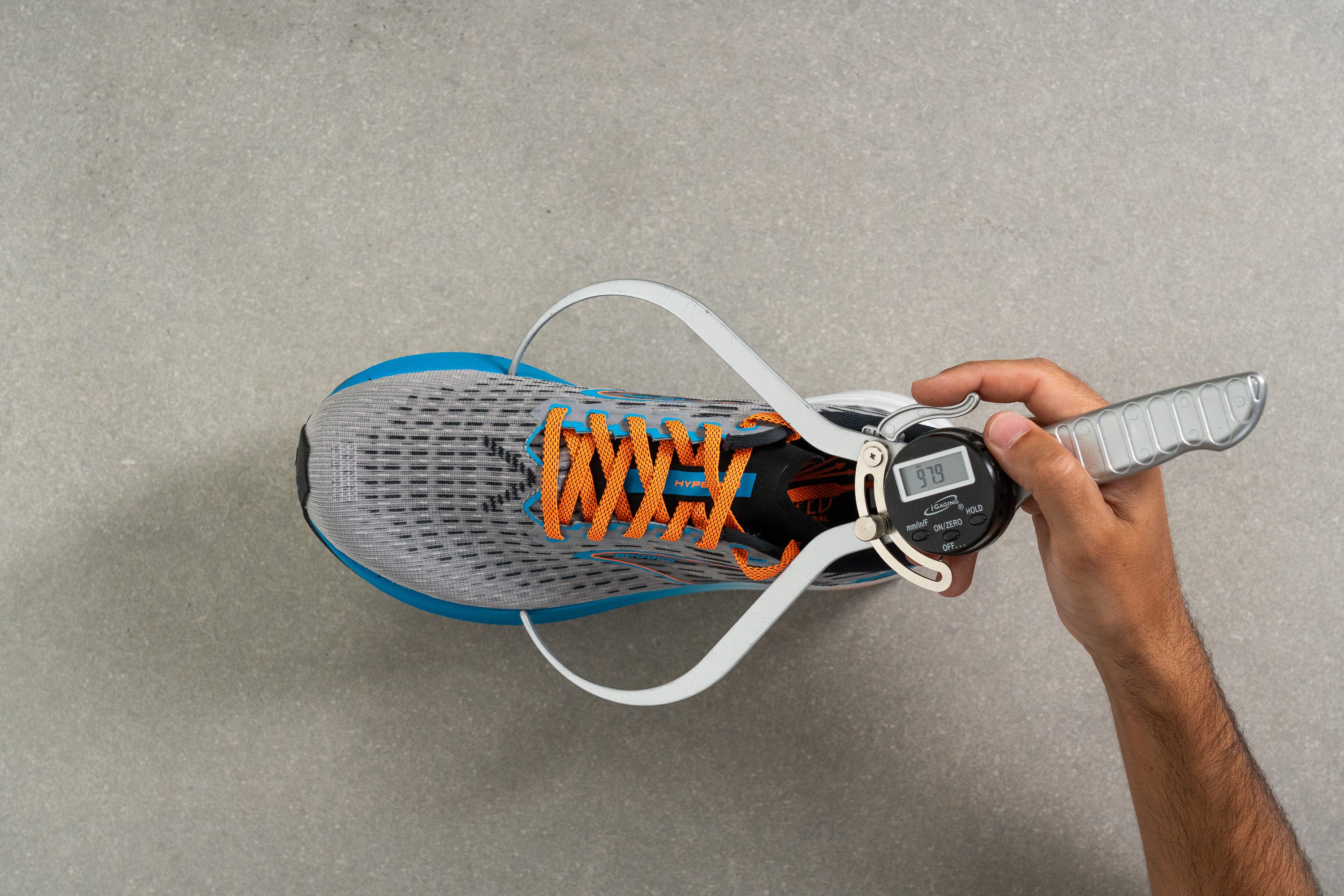
This test follows an older methodology, which is why you don't see recently tested shoes in the chart. Results from different methodologies can not be compared.
| Hyperion | 97.9 mm |
| Average | 98.5 mm |
Toebox width - big toe
Moving up to the area around the big toe, we measured the toebox to be 80.3 mm wide which is quite a bit roomier than the average shoe. This means that hotspots and blisters aren’t a concern when running in the Hyperion affords us much more space to splay out naturally, especially when it comes to tempo-trainers that typically constrict the toes to achieve an aerodynamic shape.
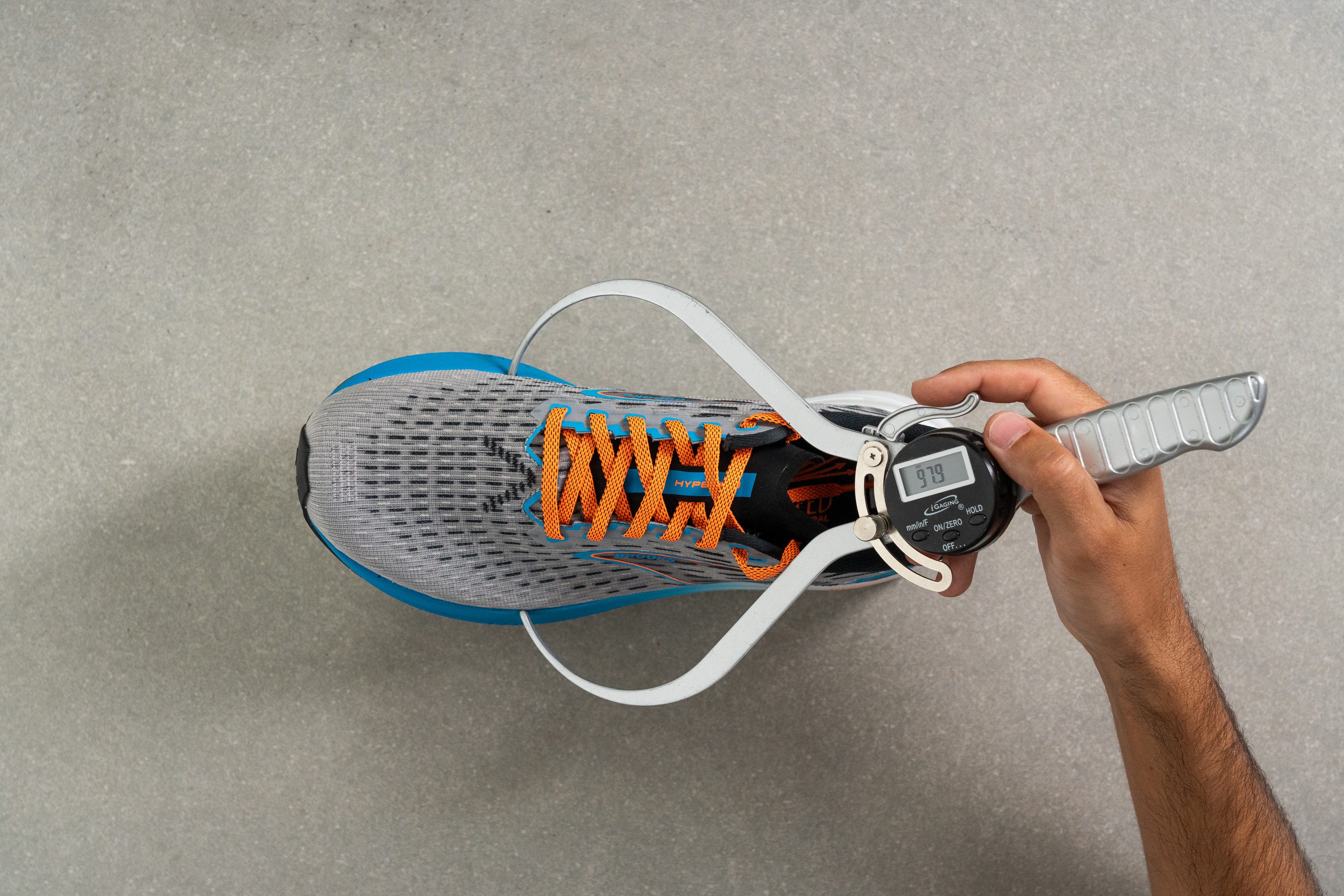
This test follows an older methodology, which is why you don't see recently tested shoes in the chart. Results from different methodologies can not be compared.
| Hyperion | 80.3 mm |
| Average | 78.4 mm |
Flexibility / Stiffness
To test the stiffness of the Hyperion, we secured it to our workbench and measured how much force is required to bend the shoe 90-degrees. With a result of only 13.6N, the Hyperion is extremely flexible compared to our current lab average. This means that the shoe has no problem bending with the natural movement of the foot which made it very comfortable and forgiving during and even after our test runs.
While responsiveness is often conflated with stiffness; the Hyperion is an exception that disproves the rule as it still manages to feel quite swift and reactive underfoot .
This test follows an older methodology, which is why you don't see recently tested shoes in the chart. Results from different methodologies can not be compared.
| Hyperion | 13.6N |
| Average | 28.1N |
Stiffness in cold (%)
After leaving the shoe in the freezer for twenty minutes, we found that only 25N of force is required to perform the same stiffness test. This is way more flexible than the average shoe and means that the Hyperion will remain remarkably flexible no matter how frigid running conditions are.
While the Hyperion is still undoubtedly flexible in the cold, an 83.5% difference in flexibility means that the shoe’s inconsistency isn’t limited to the midsole as the shoe’s flexibility takes a much more dramatic dive than the average shoe. This makes the Hyperion a bit of a Dr. Jekyll/Mr. Hyde as it will feel very different from summer to winter.
| Hyperion | 84% |
| Average | 33% |
Weight
The Hyperion tips the scale at a lean 7.45 Oz (211g). This makes it significantly lighter than our current lab average and means that pushing the pace in the Hyperion is an unburdensome breeze.
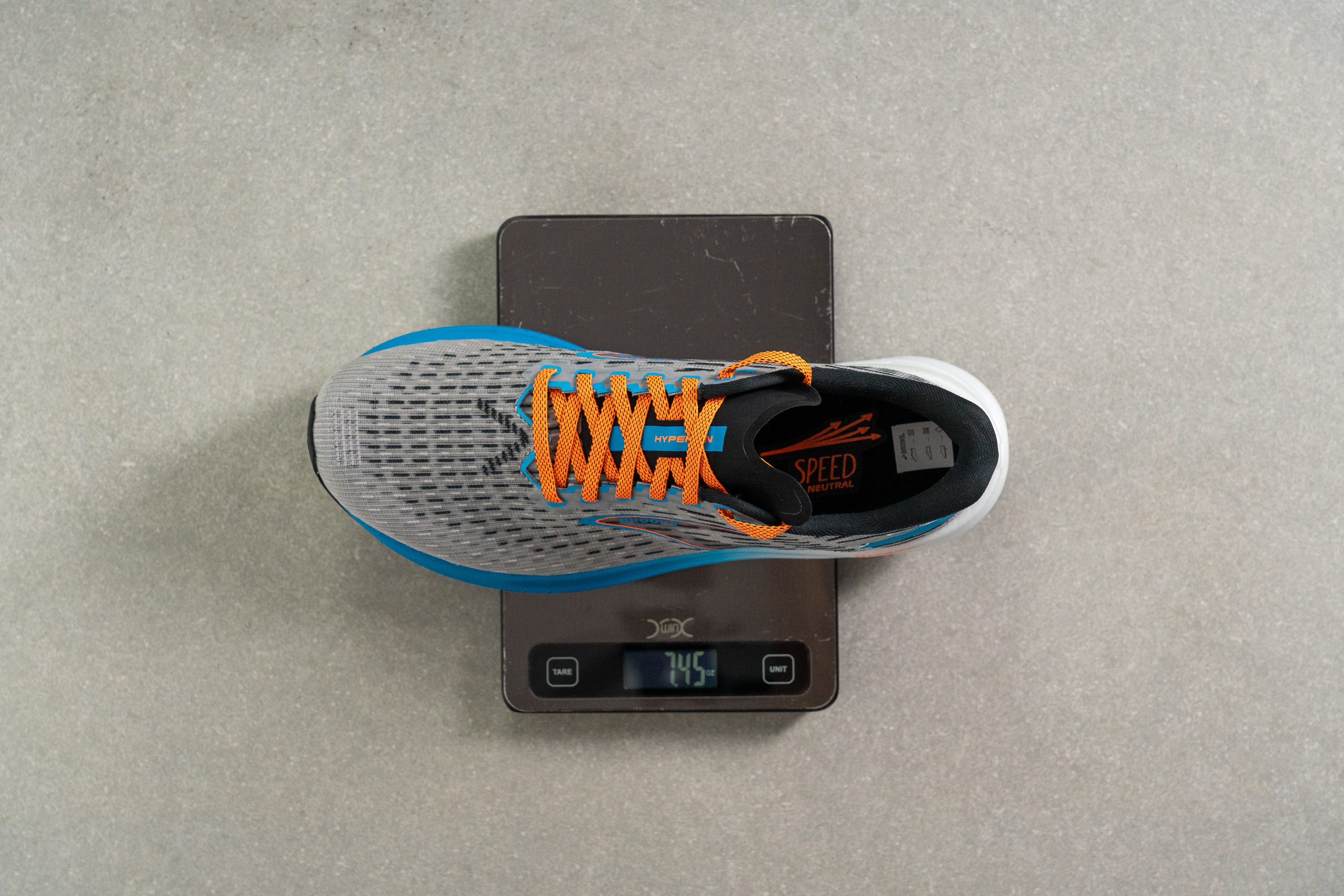
| Hyperion | 7.4 oz (211g) |
| Average | 9.3 oz (264g) |
Breathability
We pumped the Hyperion full of smoke to see how easily heat is able to escape the shoe. Despite a slow start, the Hyperion does eventually allow most of the smoke to escape pretty evenly throughout the shoe. This average performance leads us to give the shoe a breathability score of 3 out of 5.
Looking at closeup shots of the upper through our microscope reveals that while the top mesh layer is woven rather loosely with lots of gaps between braids, the lower layer is rather dense with only the evenly spaced perforations as good venting points. This explains the stuttering flow of smoke in our first test as that lower layer initially hinders heat from escaping before it reaches the airy upper layer.
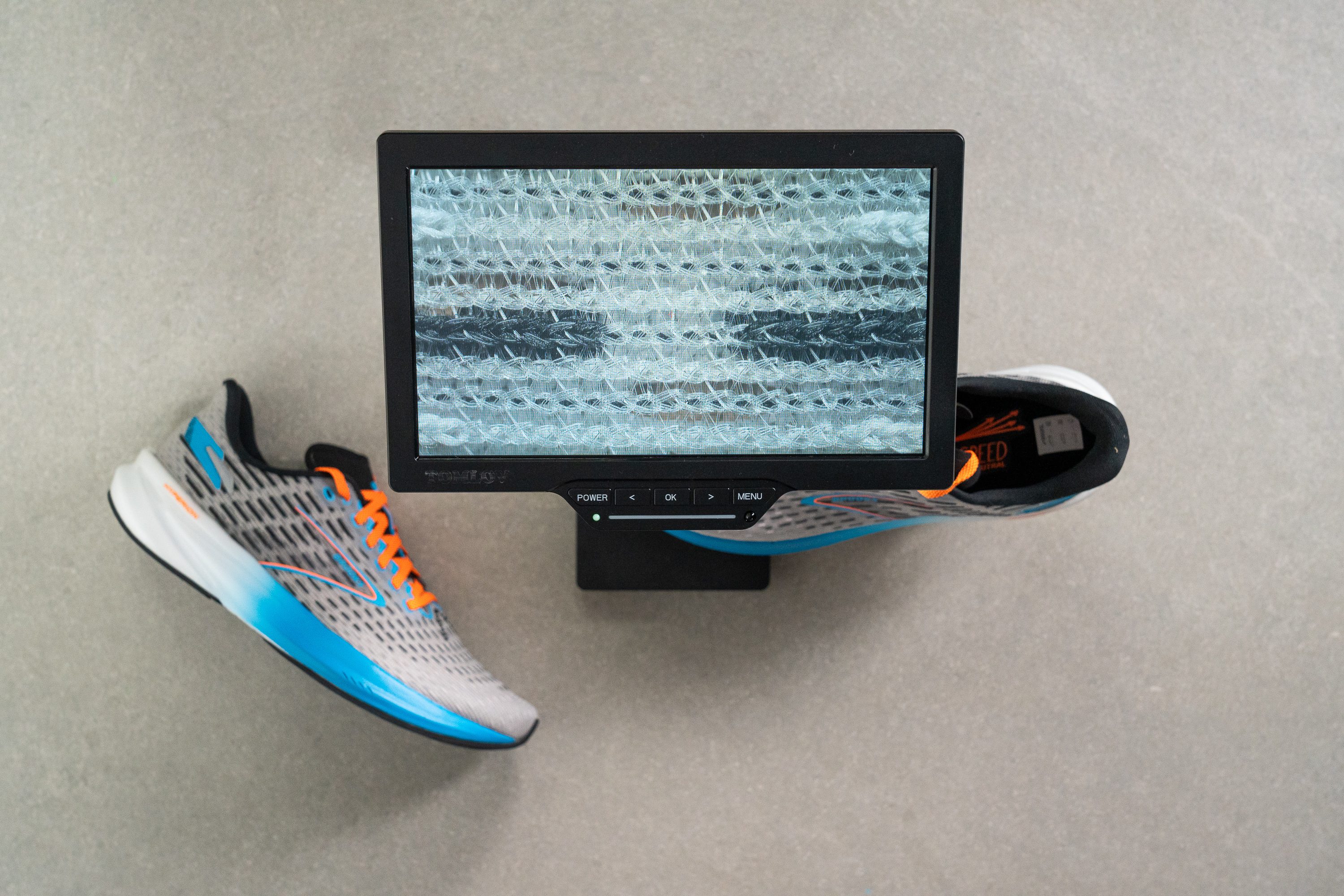
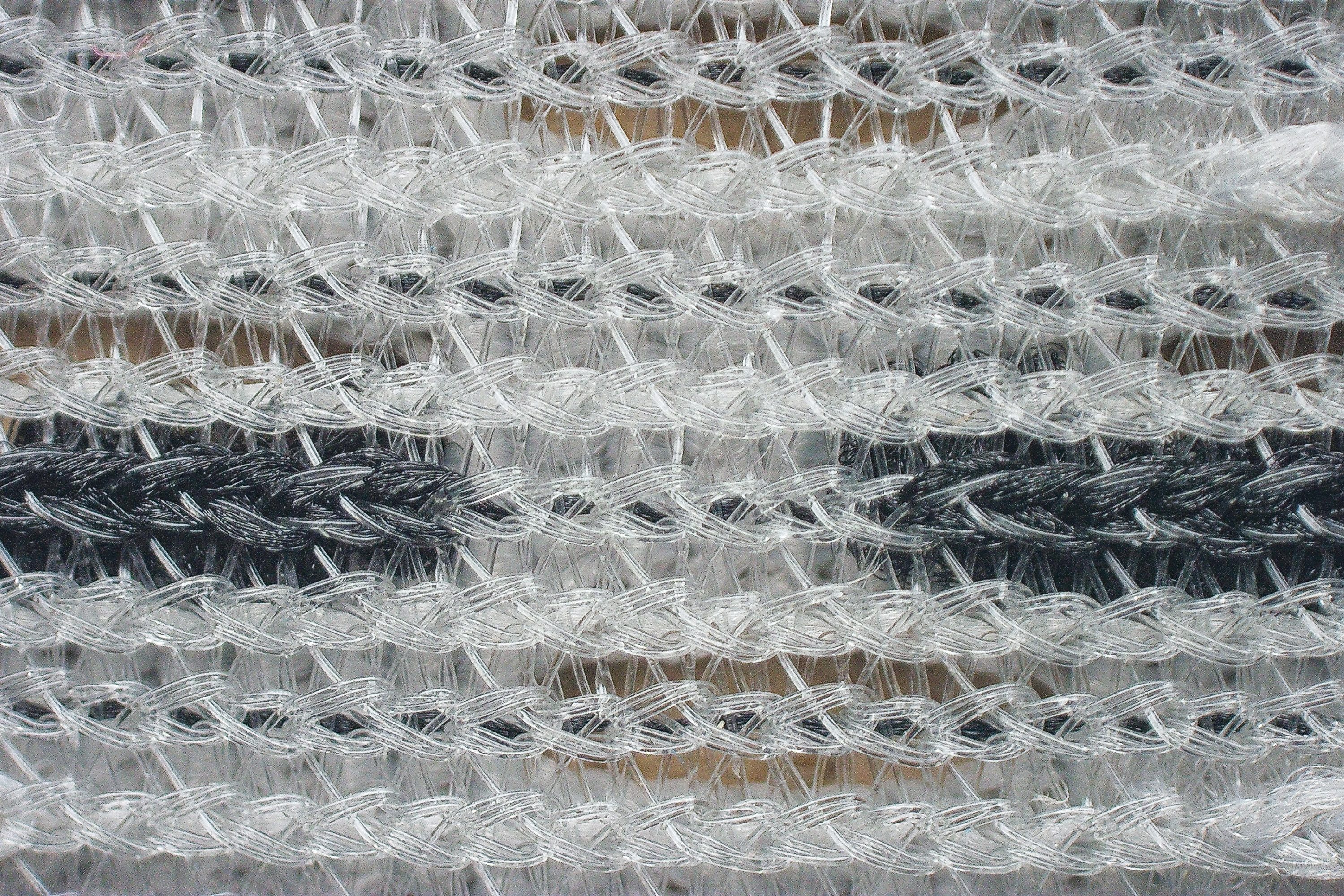
| Hyperion | 4 |
| Average | 3.7 |
Stability
Lateral stability test
While we felt pretty well-planted while standing in the Hyperion, shifting our weight from side to side reveals that the shoe does have a tendency to roll laterally. This might be fine for runners with a neutral stride, but pronating runners will be better served with a shoe that boasts stability features that prevent unnecessary foot movement. We suggest having a look at the Brooks Launch GTS 10 or the ASICS GT 2000 11.
Torsional rigidity
The Hyperion put up a nominal amount of resistance as we bent and twisted it on our hands, leading us to give the shoe a score of 2 out of 5 on our subjective scale for torsional rigidity. This level of flexibility gives the shoe a natural underfoot sensation as the Hyperion adapts and contorts with the shape of our foot with relative ease.
| Hyperion | 2 |
| Average | 3.5 |
Heel counter stiffness
The Hyperion’s heel counter put up a little more resistance against our manipulations, giving it a score of 3 out of 5 for stiffness. This allows the heel cup to secure the rearfoot without using a vice-like grip on the Achilles to keep it in place, instead comfortably squeezing it while allowing for some natural movement.
| Hyperion | 3 |
| Average | 2.9 |
Midsole width - forefoot
At 113.5 mm wide at the forefoot based on our caliper measurement, the Hyperion’s midsole is ever-so slightly wider than the average shoe we’ve tested in the lab so far. As such, forefoot strikers will have more than enough platform to ensure steady landings, while the tapering towards the toes helps to avoid any blockiness when cornering.
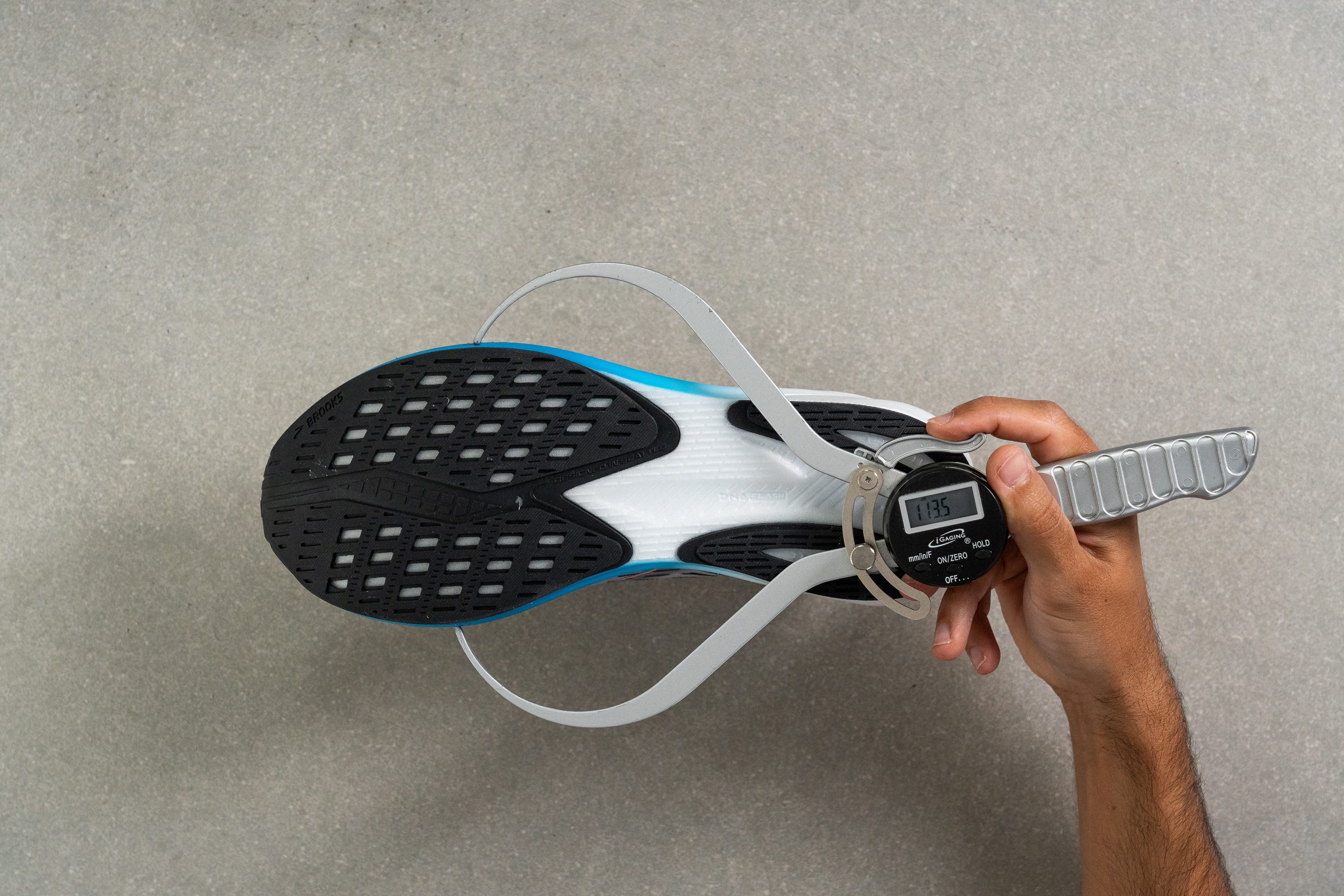
| Hyperion | 113.5 mm |
| Average | 114.4 mm |
Midsole width - heel
The Hyperion’s midsole does taper quite significantly towards the heel where it measures 83.3 mm wide according to our caliper. This is a lot narrower than our current lab average and while this lends the shoe an aerodynamic silhouette, it also means that heel striking runners will feel more unstable during landings in this shoe than their forefoot/midfoot striking counterparts.

| Hyperion | 83.3 mm |
| Average | 90.7 mm |
Durability
Toebox durability
To test the durability of the Hyperion; we whipped out our trusty dremel, fired it to 10K RPM and applied it to the shoe’s toebox with a force of 3.2N for four seconds. Once the test was over and the shreds of fabric had settled, we were left with a yawing hole in the upper material big enough to pop at least one of our toes out. This lacklustre performance leads us to give the Hyperion’s toebox a durability score of 1 out of 5.
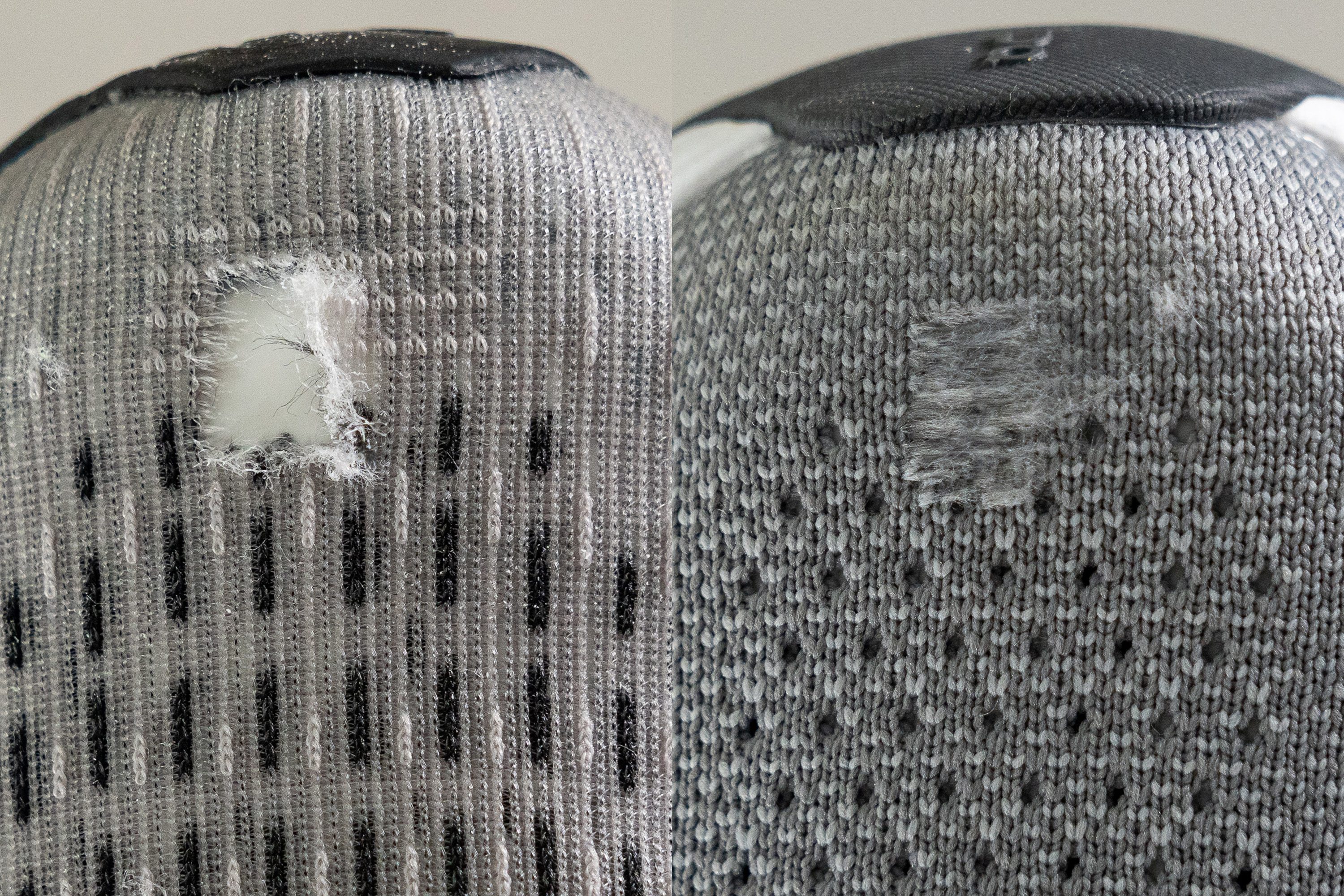
| Hyperion | 1 |
| Average | 2.6 |
Heel padding durability
We similarly tested the durability of the heel padding by firing up our dremel to the same parameter as the previous test and unleashed it against the shoe’s heel collar. Unlike with the toebox, our tool took a moment before it was able to bite into the material and send scraps of material flying all over our workbench. The aftermath of the four second test isn’t as devastating as it was on the toebox, with only a small section being worn all the way down. This leads us to give the shoe a sub-par score of 2 out of 5 for heel padding durability.
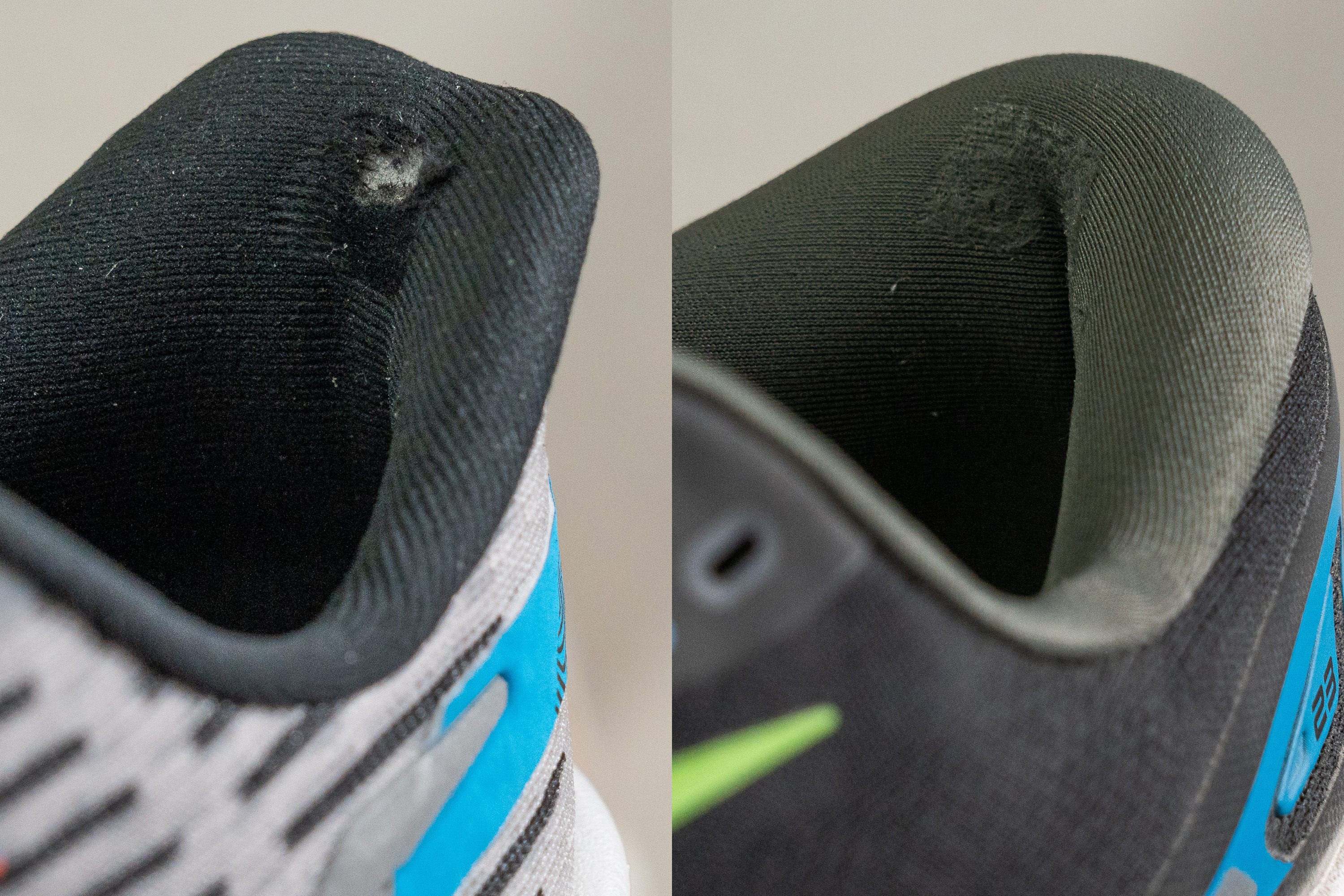
| Hyperion | 2 |
| Average | 3.4 |
Outsole hardness
Using our durometer, we measured the outsole hardness to be 79.1 HC, which is ever so slightly softer than our current lab average but still within range. This level of hardness lies in that sweet spot between hard and durable versus soft and grippy.
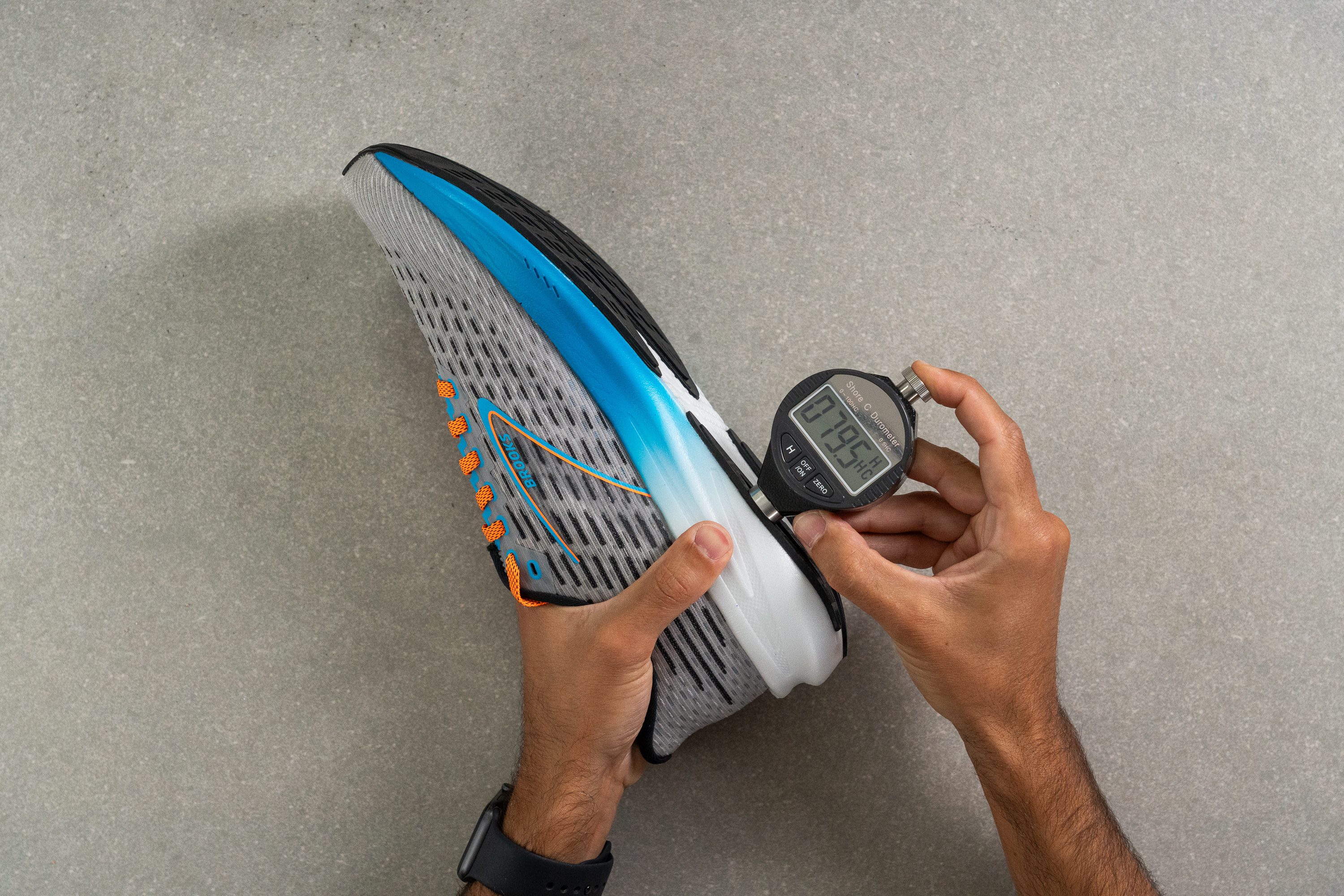
| Hyperion | 79.1 HC |
| Average | 79.2 HC |
Outsole durability
We again turned to our dreaded dremel to test the durability of the Hyperion’s outsole. At first our tool’s grinding element doesn’t seem to have much of an effect on the shoe’s outsole, but soon enough the rubber starts to fly with 0.69 mm of material shorn away by the end of the twenty second test.
This result makes the Hyperion’s outsole much more durable than the average shoe which allows us to safely predict that the shoe should last around 500 miles before significant signs of wear and tear affect the shoe’s performance.
| Hyperion | 0.7 mm |
| Average | 1.1 mm |
Outsole thickness
According to our caliper, the Hyperion’s outsole measures 3.0 mm thick. While this is slightly thinner than our current lab average, the result of our durability test demonstates that not much rubber is needed at the bottom of the shoe, with any skimped rubber serving to keep weight off this lightweight shoe.
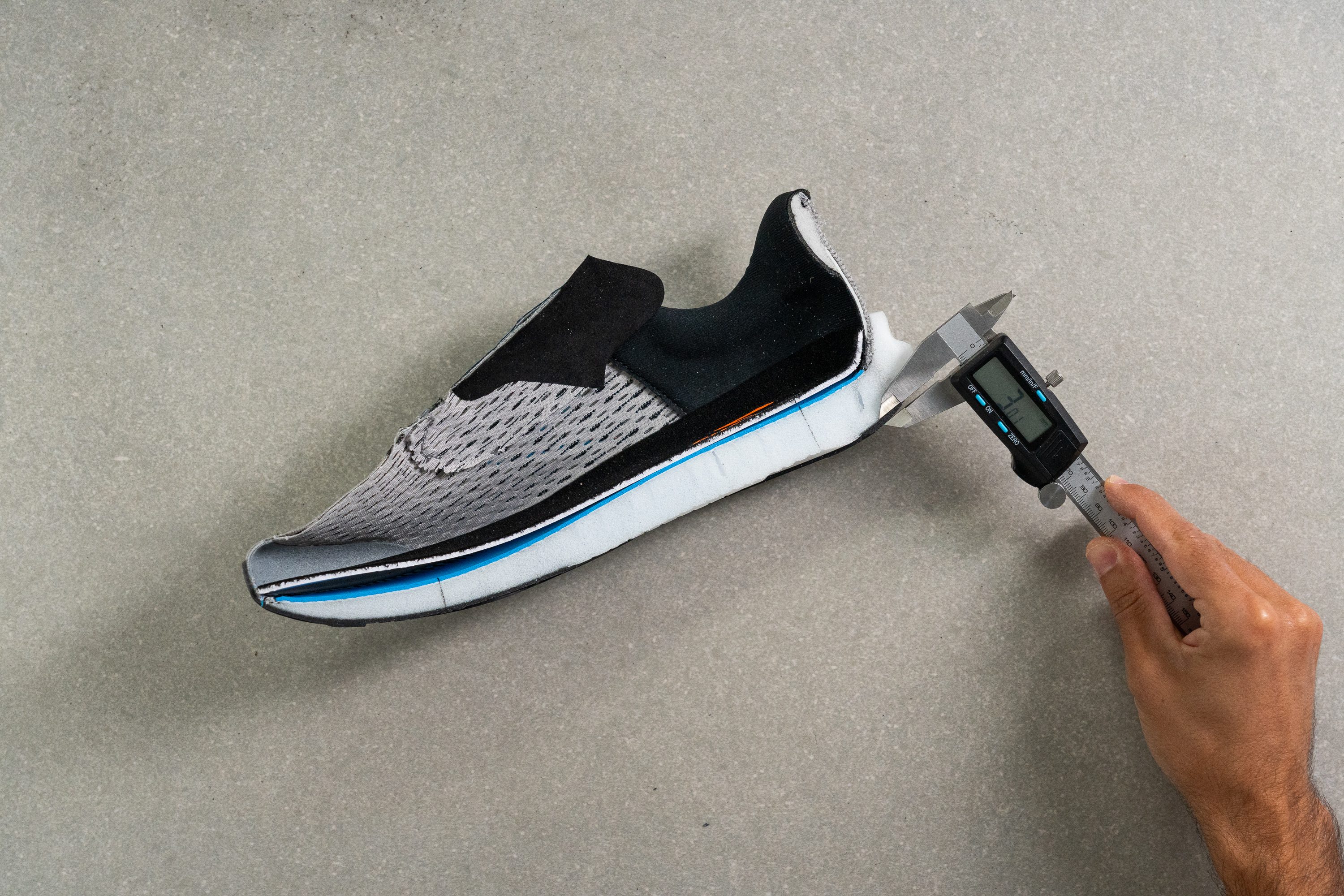
| Hyperion | 3.0 mm |
| Average | 3.2 mm |
Misc
Insole thickness
At 2.8 mm according to our caliper, the Hyperion’s midsole isn’t as thick as that of the average shoe. Despite this, however, it still provided us with a soft landing surface within the shoe that works with the midsole to protect us from impact.
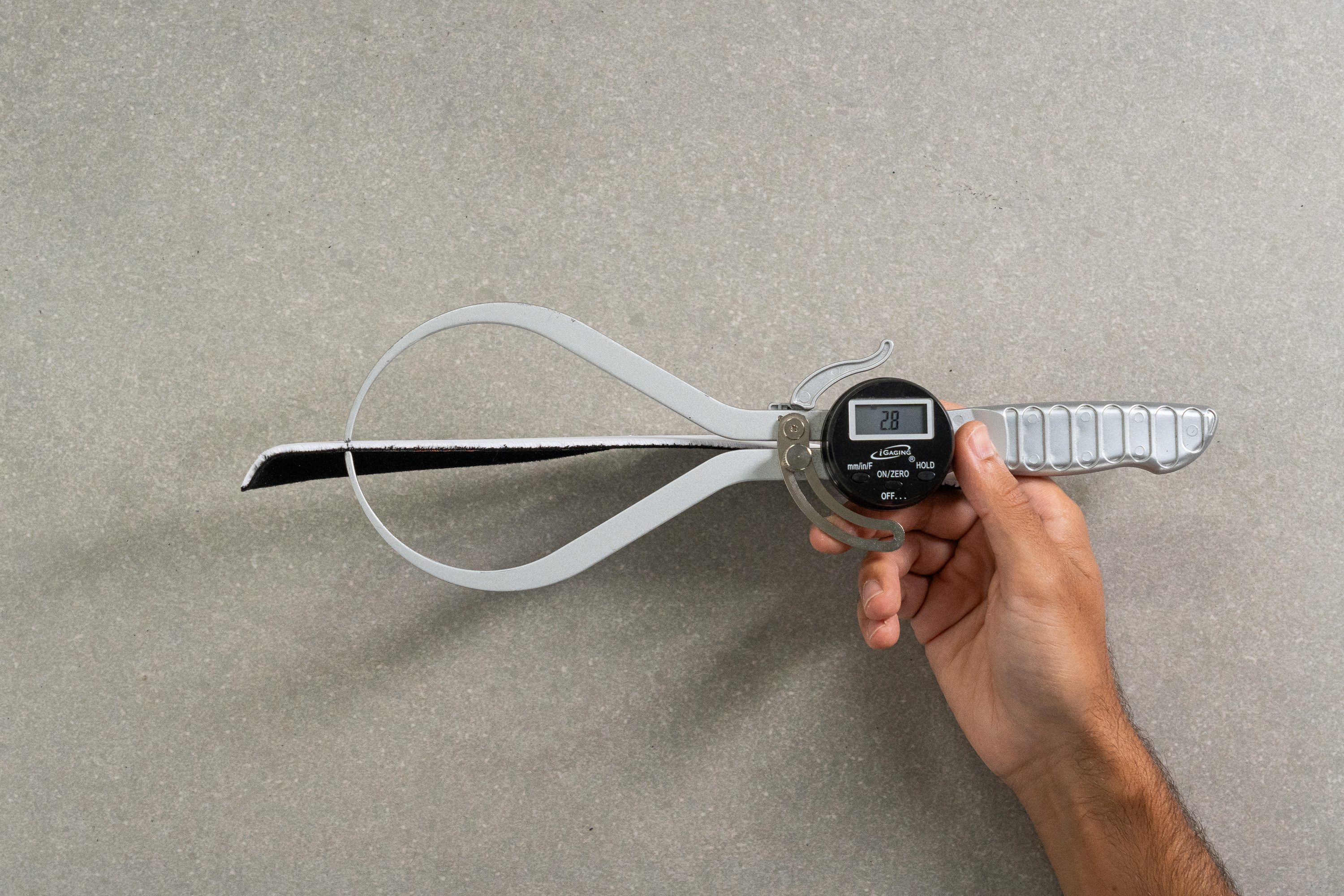
| Hyperion | 2.8 mm |
| Average | 4.5 mm |
Removable insole
The Hyperion’s insole is fully removable, so runners in need of custom orthotics should be able to use them with this shoe.
| Hyperion | Yes |
Midsole softness in cold

Midsole softness in cold (%)
We left the Hyperion in the freezer for twenty minutes to simulate exposure to cold weather then pressed our durometer against the midsole once again; this time getting a reading of 30.6 HA. This is about as firm as the average shoe becomes when tested under similar conditions, and means that the Hyperion will definitely feel much less cushioned during winter runs.
Becoming 48.5% firmer in the cold means that the Hyperion is much more inconsistent depending on the temperature compared to the average shoe, which doesn’t stiffen up as drastically. As such, the Hyperion will feel like a tale of two shoes between summer and winter.
| Hyperion | 49% |
| Average | 24% |
Reflective elements
For nocturnal runners, the Hyperion features a reflective streak near the ankle that provides a minimal level of visibility in the dark. Still, we recommend staying in well lit areas or investing in reflective clothing when running at night.
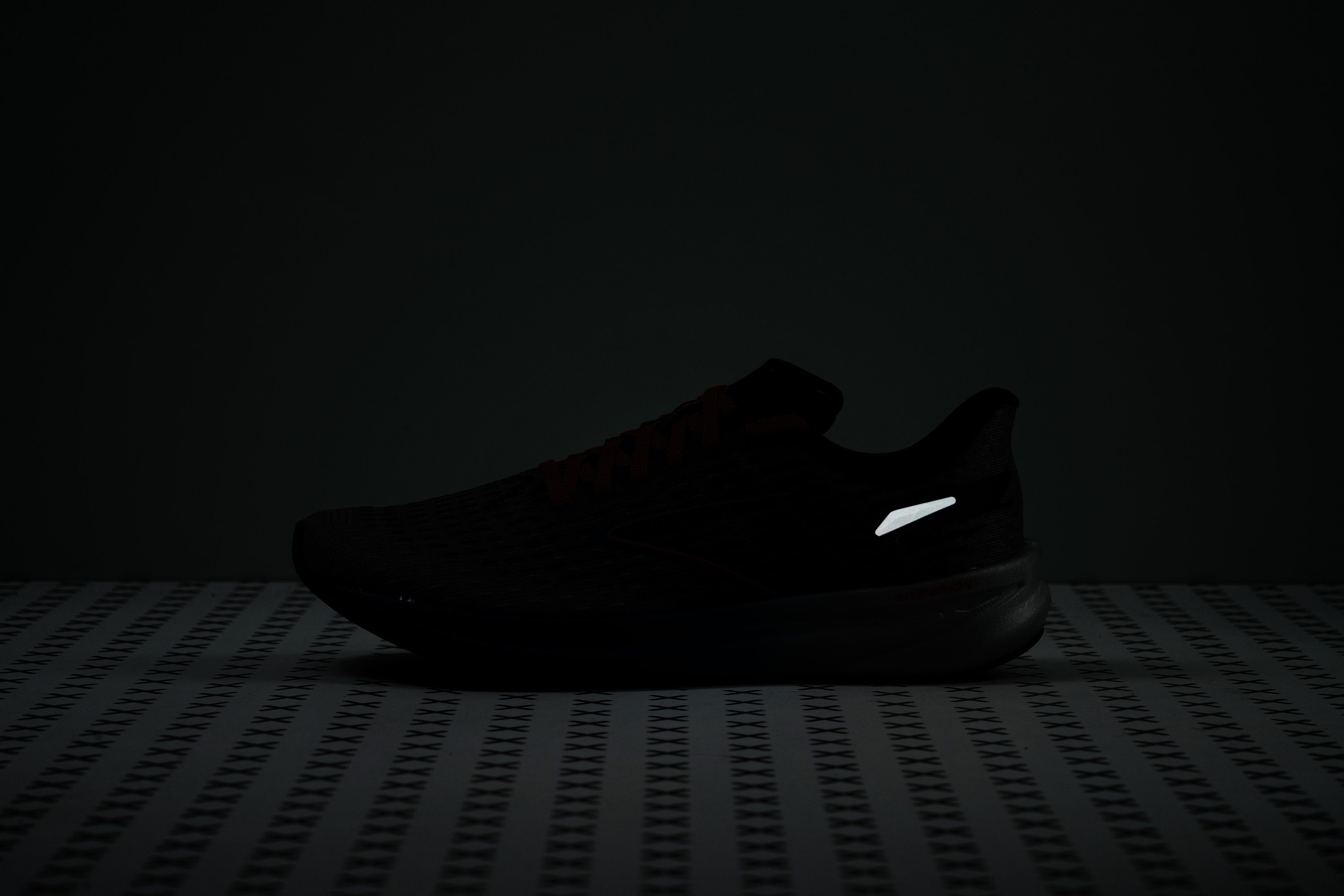
| Hyperion | Yes |
Tongue padding
We measured the Hyperion’s tongue to be 3.8 mm thick. While this is a little leaner than our current lab average, this is more padding than we typically see from speed-oriented shoes. This means that the Hyperion feels comfortable around the instep with no perceptible sensation of lace bite once we were locked in, which is an improvement from the shoe’s previous iteration.
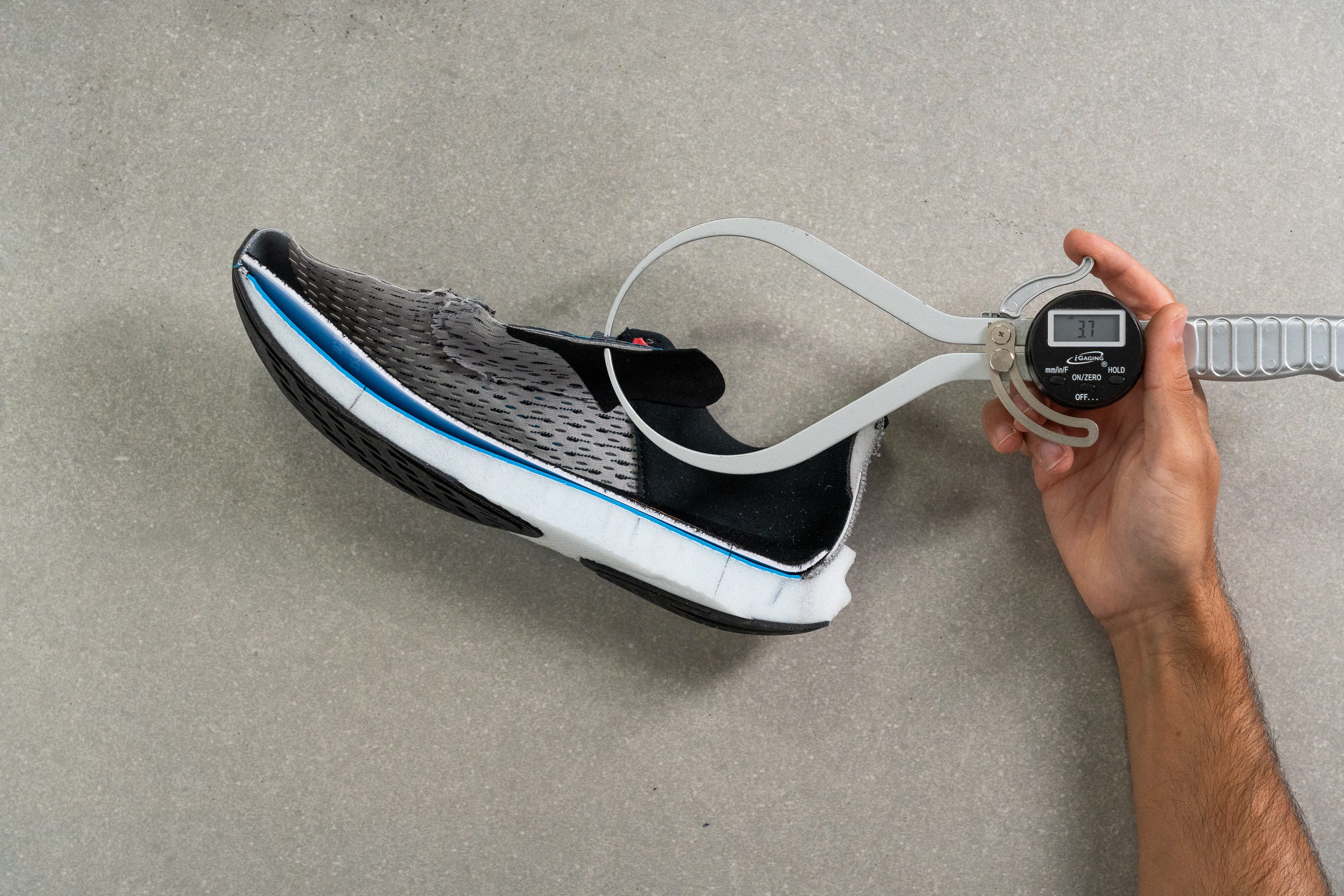
| Hyperion | 3.7 mm |
| Average | 5.8 mm |
Tongue: gusset type
The Hyperion’s tongue is semi-gusseted on both sides which helps to mitigate slippage from side to side.
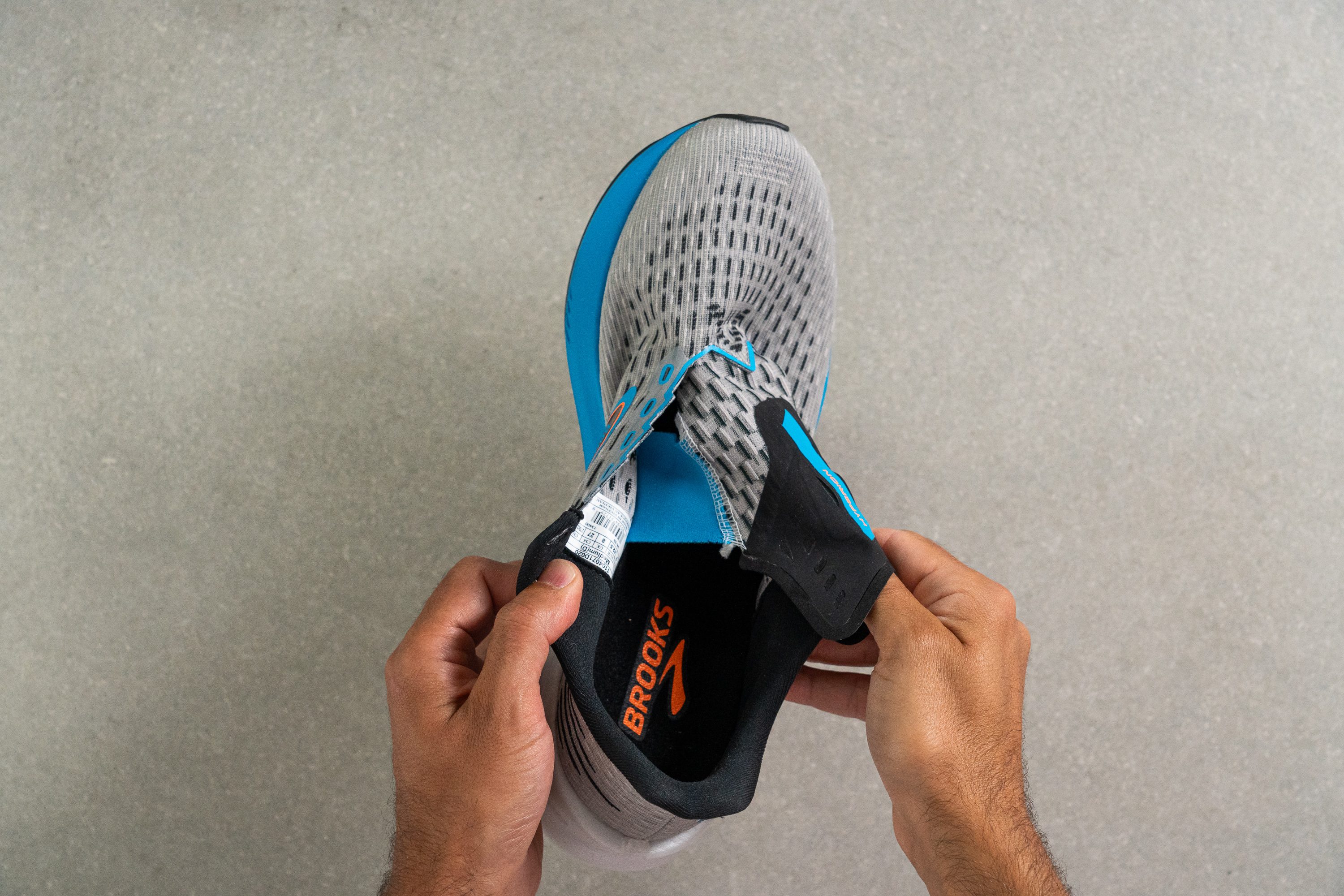
| Hyperion | One side (semi) |

